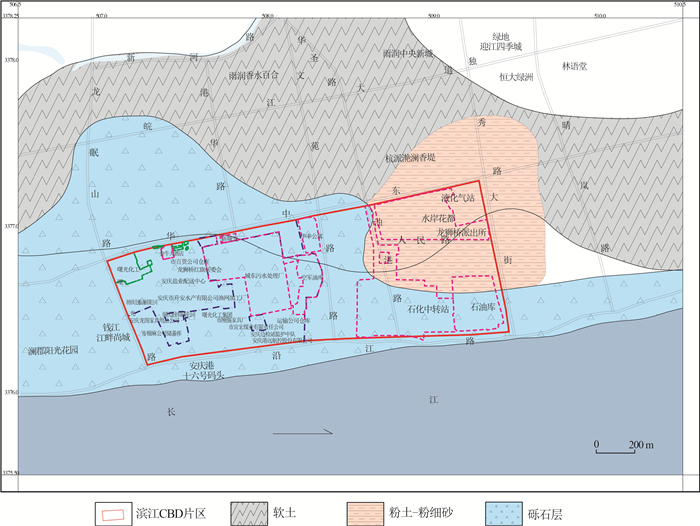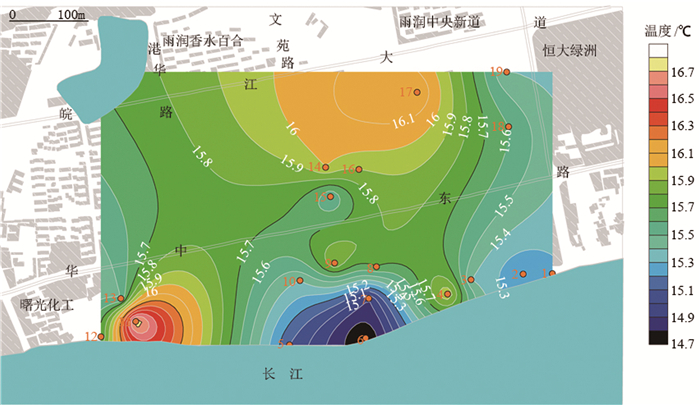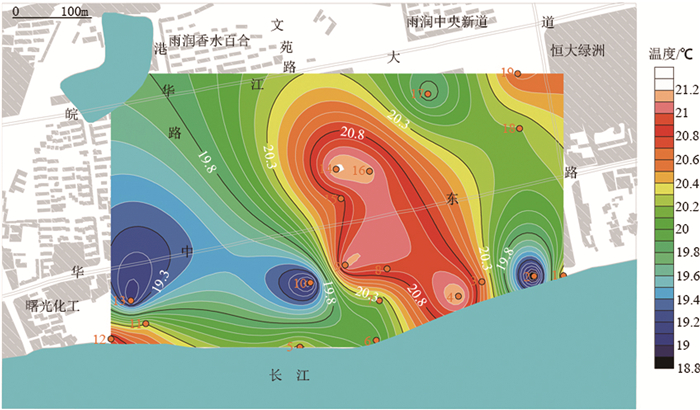Ground temperature prediction based on shallow-surface ground temperature and in-situ thermophysical parameters
-
摘要:
近年,地热资源作为一种新颖的清洁能源已经引起广泛的关注。中国浅层地热能资源丰富,但探测手段限制其大规模发展。热物性参数是地热能赋存载体的关键参数之一,决定了热能在岩土体中的传播速度和岩土体温度场的分布。因此,采用基于热物性参数研发的浅层测温和原位热物性参数测试仪开展现场试验,获取地温、热物性参数等数据。采用一维稳态热传导理论建立地温场预测模型,利用不同岩性实测、概化热物性参数进行恒温层地温场分布预测。结果表明,浅层地温场受江水流动影响较大。采用岩性概化与实测热物性参数对恒温层地温场预测几乎一致,因此,利用研发的仪器及模型进行恒温层地温场分布预测是十分有效的。另外,该方法方便快捷,可利用其对浅层地热能开发利用提供合理的建议,并在实际工程中推广应用。
Abstract:In recent years, geothermal resources as a new clean energy have begun to attract widespread attention.China is rich in shallow geothermal energy resources, but exploration methods limit its large-scale development. Thermophysical parameter is one of the key parameters of geothermal energy carrier, which determines the thermal energy transmission speed and the distribution of the temperature field of the rock and soil. Therefore, shallow temperature measurement and in-situ thermophysical parameter tester based on thermophysical parameters were used to acquire ground temperature and thermophysical parameters in the field tests.The one-dimensional steady-state heat conduction theory was used to establish the geothermal field prediction model, and the lithological measurement and generalized thermal physical parameters were used to predict the geothermal field distribution of the constant temperature layer. The results show that the shallow geothermal field is greatly affected by the river water flow. The adoption of lithology generalization and the measured thermal physical parameters resulted in almost the same prediction of the temperature field of the constant temperature layer, indicating that it is very effective to predict the distribution of the temperature field of the constant temperature layer by using the developed instruments and models. In addition, the method is convenient and fast, which can be used to provide reasonable suggestions for the development and utilization of shallow geothermal energy, and it can be widely used in practical projects.
-

-
表 1 研究区浅层测量结果
Table 1. Shallow ground temperature survey results in the study area
孔号 01 02 03 04 05 06 07 08 09 10 1.5 m地温/℃ 15.0 15.0 15.1 15.7 14.8 14.5 14.7 15.4 15.6 15.2 2.5 m地温/℃ 15.3 15.2 15.4 16.0 15.1 14.7 14.9 15.7 15.9 15.4 1.5 m导热系数W/(K·m) 0.732 0.927 0.689 0.652 0.729 0.687 0.813 0.837 0.779 0.955 2.5 m导热系数W/(K·m) 0.801 0.759 0.745 0.639 0.795 0.825 0.707 0.962 0.957 0.974 孔号 11 12 13 14 15 16 17 18 19 1.5 m地温/℃ 16.5 15.4 15.3 15.7 15.2 15.6 16.0 15.3 15.1 2.5 m地温/℃ 16.8 15.7 15.5 16.0 15.5 15.9 16.2 15.6 15.4 1.5 m导热系数W/(K·m) 0.984 0.968 1.080 0.995 1.202 1.036 1.004 1.064 1.184 2.5 m导热系数W/(K·m) 1.018 1.306 1.125 1.030 1.529 0.995 1.087 1.027 1.064 表 2 研究区实测导热系数平均值
Table 2. Average value of measured thermal conductivity in the study area
深度/m 3 4 5 6 7 8 9 10 11 土质 粉土 粉土 粉土 淤泥质粉土 淤泥质粉土 淤泥质粉土 淤泥质粉土 淤泥质粉土 淤泥质粉土 导热系数W/(K·m) 0.622 1.729 0.954 1.845 1.384 1.443 1.563 1.610 1.356 深度/m 12 13 14 15 16 17 18 19 20 土质 淤泥质粉土 淤泥质粉土 淤泥质粉土 淤泥质粉土 淤泥质粉土 淤泥质粉土 淤泥质粉土 淤泥质粉土 淤泥质粉土 导热系数W/(K·m) 1.244 1.227 0.424 0.797 1.139 1.883 1.811 1.111 0.755 -
[1] 王贵玲, 蔺文静, 韩玉英, 等. 浅层地热能研究现状及亟待开展的工作[J]. 工程建设与设计, 2007, 11: 1-4. https://www.cnki.com.cn/Article/CJFDTOTAL-GCJS200711002.htm
[2] 黄凯. 秦岭越岭深埋隧道地温预测方法[J]. 山西建筑, 2009, 35(18): 295-296. doi: 10.3969/j.issn.1009-6825.2009.18.186
[3] 杨小强, 吴建良. 基于多年观测数据的地温预测模型[J]. 山西建筑, 2014, 40(6): 150-151. https://www.cnki.com.cn/Article/CJFDTOTAL-JZSX201406080.htm
[4] 周斌, 李辑, 李晶, 等. 辽西地区地温预测方法探析[J]. 资源与环境科学, 2015, (21): 232-235. https://www.cnki.com.cn/Article/CJFDTOTAL-ANHE201521141.htm
[5] 孙立军, 秦健. 沥青路面温度场的预估模型[J]. 同济大学学报(自然科学版), 2006, 34(4): 480-483. doi: 10.3321/j.issn:0253-374X.2006.04.011
[6] 刘德平, 汪双杰, 金龙. 共和至玉树公路多年冻土地温拟合模型[J]. 中国公路学报, 2015, 28(12): 100-105. https://www.cnki.com.cn/Article/CJFDTOTAL-ZGGL201512016.htm
[7] 刘德平, 汪双杰, 王彩勤. 国道214线鄂拉山至清水河段多年冻土地温预测模型研究[J]. 公路交通科技, 2016, 33(5): 53-60. https://www.cnki.com.cn/Article/CJFDTOTAL-GLJK201605009.htm
[8] 陈建兵, 刘志云, 崔福庆, 等. 青藏高原工程走廊带多年冻土辨识及年平均地温预估模型[J]. 中国公路学报, 2015, 28(12): 33-51. https://www.cnki.com.cn/Article/CJFDTOTAL-ZGGL201512006.htm
[9] 刘亚俊, 贾德祥, 童庆丰. 矿井三维地温场的反演分析[J]. 阜新矿业学院学报(自然科学版), 1995, 14(z2): 8-11. https://www.cnki.com.cn/Article/CJFDTOTAL-FXKY502.002.htm
[10] 李浪, 罗新荣, 张克兵. 丁集煤矿深部地温预测[J]. 黑龙江科技学院学报, 2010, 20(5): 340-342. https://www.cnki.com.cn/Article/CJFDTOTAL-HLJI201005004.htm
[11] 张进平, 杜建国, 何铁柱. 基于Tough2软件的深部地温场模拟及影响因素分析——以苏北褶皱构造区为例[J]. 城市地质, 2014(9): 35-40. https://www.cnki.com.cn/Article/CJFDTOTAL-CSDZ2014S1010.htm
[12] 于连广, 吴喜平, 李昊翔. 三维地铁隧道土壤温度预测模型[J]. 沈阳工业大学学报, 2011, 33(2): 234-240. https://www.cnki.com.cn/Article/CJFDTOTAL-SYGY201102023.htm
[13] 翰力群, 毕思文, 宋世欣. 地表层温度的级联递推预测模型研究[J]. 中国科学: 技术科学, 2006, 36(增刊): 29-37. https://www.cnki.com.cn/Article/CJFDTOTAL-JEXK2006S1003.htm
[14] Xie Y Y, Zhang Y J, Zhang T, et al. 2 m survey method and its improved device application in Dongshan geothermal field in Xiamen in China[J]. Environmental Earth Sciences, 2016, 75(18): 1290.
[15] 张延军, 张通, 殷仁朝, 等. 基于2 m测温法的地热异常区探测及地温预测[J]. 吉林大学学报(地球科学版), 2017, 47(1): 189-196. https://www.cnki.com.cn/Article/CJFDTOTAL-CCDZ201701018.htm
[16] 胡圣标, 何丽娟, 汪集旸. 中国大陆地区大地热流数据汇编(第三版)[J]. 地球物理学报, 2001, 44(5): 611-626. https://www.cnki.com.cn/Article/CJFDTOTAL-DQWX201608015.htm
[17] Elachi C, Zyl J V. Introduction to the physics and techniques of remote sensing[M]. New Jersey: John Wiley and Sons, 2006.
-




 下载:
下载:



